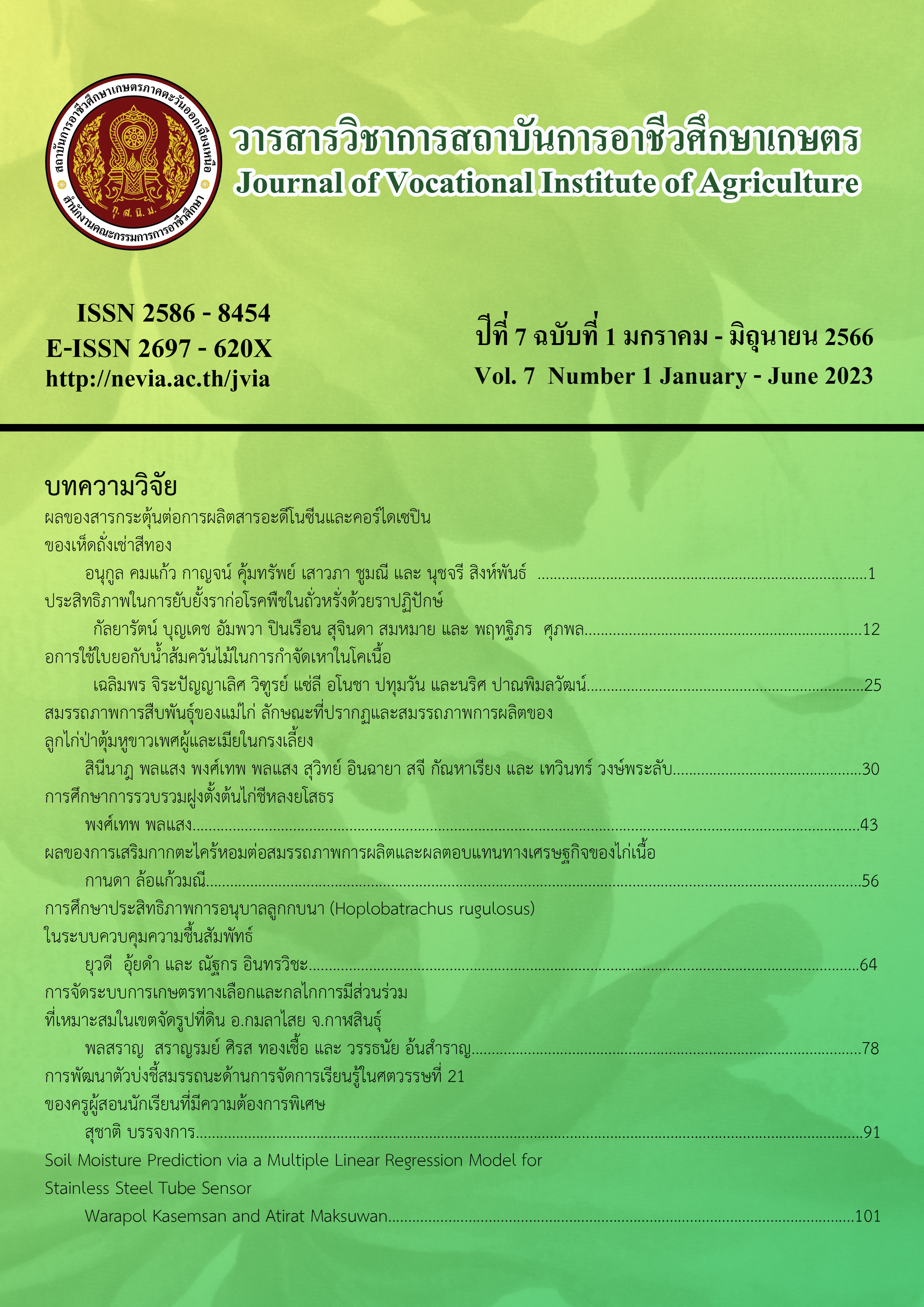Study of Collecting the Initial Chicken Flocks of Chee Long Yasothon Chicken
Main Article Content
Abstract
The purpose of this study was to collect the initial chicken flocks with desired traits by breeding 1-year-old Thai red junglefowl of Yasothon Province using male with black-red, and female with red-gray feather. They all had white earrings and black shins. A total of 9 pens and 36 chickens were used in this experiment. Four chickens, male and female at a ratio of 1:3, were placed in each pen. Eggs were incubated for F1 generation chick production. Numbers of the F1 generation chickens with different feather and shin colors were recorded. The observed phenotypes were compared with the expected phenotypes according to the Mendel's law using the chi-square method. The white-feathered chickens were selected as breeders. A total of 6 pens and 24 chickens were used in this stage of the experiment. Four chickens, male and female at a ratio of 1:3, were placed in each pen. Eggs were incubated for F2 generation chick production. The new born chickens were randomly placed in pens. A completely randomized design was used for this stage of the experiment. There were two treatments and six replications. Each treatment consisted of 6 pens, 3 chickens per pen, a total of 36 chickens were used at this stage. After 12 weeks, the body weights and body characteristic scores of the F2 generation chickens in this experiment were analyzed. It was found that the ratio of the feather colors, red:white was 8.12:1 and the ratio of the shin color, black:yellow was 2.02:1 (P>0.05). It was predicted that the 3 pairs of genes were the complete dominant genes, showing red feather with black shin and a homozygous recessive gene showed white feather with yellow shin. The body weights of the white-feathered chickens with black and with yellow shin were not statistical different (P>0.05). The body characteristic scores of the white-feathered chickens with black shin were higher than the chicken with yellow shin (P<0.01). Therefore, from this research, the white-feathered with black shin chicken with the recessive gene had economically important traits suitable for building the initial flock to develop Chee Long Yasothon chicken strains for future genetic distribution continuously.
Article Details

This work is licensed under a Creative Commons Attribution-NonCommercial-NoDerivatives 4.0 International License.
The content and information in articles published in the Journal of Vocational Education in Agriculture are the opinions and responsibility of the article's author. The journal editors do not need to agree or share any responsibility.
Articles, information, content, etc. that are published in the Journal of Vocational Education in Agriculture are copyrighted by the Journal of Vocational Education in Agriculture. If any person or organization wishes to publish all or any part of it or to do anything. Only prior written permission from the Journal of Vocational Education in Agriculture is required.
References
Polsang, S. (2020). The Conservation of Thai Red Junglefowl (Gallus gallus gallus) by Semen Cryopreservation. (Doctoral dissertation, Khon Kaen University). (in Thai)
Polsang, S., et al. (2022). A study of annual variation on semen characteristics of Thai red junglefowl (Gallus gallus gallus). Khon Kaen Agriculture Journal, 50(2), 505-515. (in Thai)
Polsang, S., et al. (2022). Effects of extenders and cryoprotectants on cryopreservation of Thai red junglefowl (Gallus gallus gallus) spermatozoa. Cryobiology, 106, 48-54.
Tisdell, C. (2003). Socioeconomic causes of loss of animal genetic diversity: analysis and assessment. Ecological economics, 45, 365-376.
Prathepha, P. (2008). Gene Research. Mahasarakham: Mahasarakham University Press. (in Thai)
Piyachoknakun, S. (2009). DNA Markers: From Basics to Applications. Bangkok: Kasetsart University Press. (in Thai)
Kampiranon, A. (2003). Human Genetics. Bangkok: Tex and Journal Publication Co., Ltd. (in Thai)
Akaboot, P. (2007). Identification and DNA marker detection of Thai native chickens using microsatellite. (Master Thesis, Khon Kaen University). (in Thai)
Lekagul, B. & Round, P. D. (1991). A Guide to the Birds of Thailand. Bangkok: Saha Kam Bhaet Co. Ltd.
Biodiversity Research Group. (2016). Kai Tang. Bangkok: Animal Breeding Division, Department of Livestock Development, Ministry of Agriculture and Cooperatives. (in Thai)
Kunutthirit, S. (2022). Principles and basic knowledge of animal breeding. Available from http:// www.dpogenetics.com/index.php/article-summary-menu/65-breeding-principle. Accessed date: 2 July 2022. (in Thai)
Rofii, A., et al. (2018). Phenotypic characteristics of Indonesian native chickens. Journal of Animal Behaviour and Biometeorology, 6, 56-61.
Lopez Jr., R. V., et al. (2013). Phenotypic characterization of native chicken in Palawan, Philippines. Philippine Journal of Veterinary and Animal Sciences, 39(2), 147-156.
Dahloum, L., et al. (2016). Phenotypic characterization of the indigenous chickens (Gallus gallus) in the northwest of Algeria. Archives Animal Breeding, 59, 79–90.
Buranawit, K., et al. (2016). Phenotypic characterization of Thai native black-bone chickens indigenous to northern Thailand. Thai Journal of Veterinary Medicine, 46(4), 547-554.
Olby, R. (2022). Gregor Mendel. Available from https://www.britannica.com/biography/Gregor-Mendel. Accessed date: 2 July 2022.
Vongpralub, T., et al. (2011). A comparison of simple vapour method and programable freezer on motility and fertility of frozen Thai native chicken semen. In The 3rd international conference on sustainable animal agriculture for developing countries (SAA-DC 2011) (p.649-652). 26-29 July, 2011. Nakhon Ratchasima, Thailand.
Meilgaard, C., et al. (2007). Sensory Evaluation Techniques. Baca Raton: CRC Press.
Statistical Analysis System Institute (SAS). (2018). SAS/STAT user’s guide SAS University Edition 9.4. North Carolina: SAS Institute Inc.

